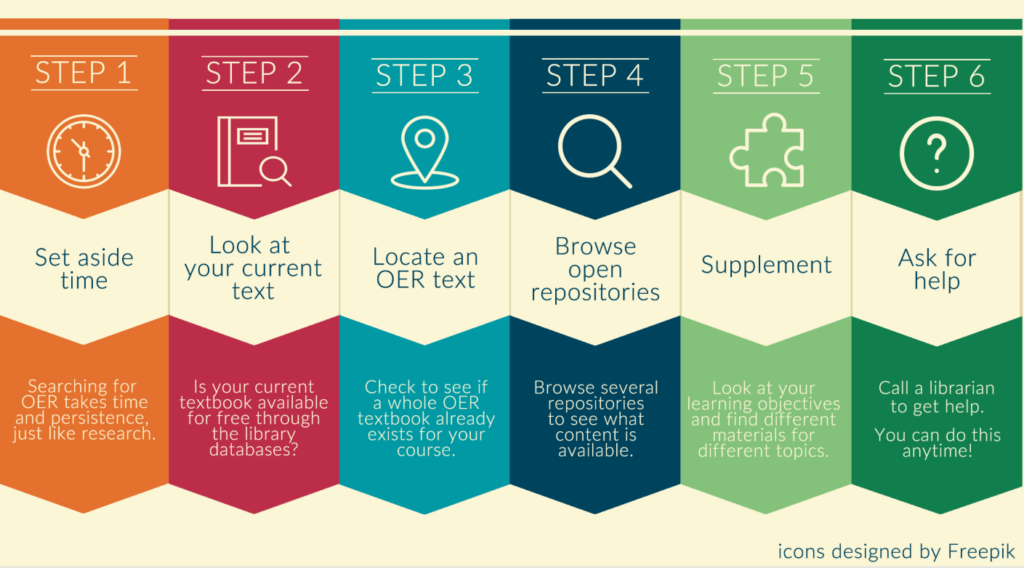One of the most transformative aspects of today’s education is the ability to modify an open textbook, offering educators a practical way to tailor content to meet specific learning objectives and student needs. What are the best practices in customizing an open resource?

Conducting thorough reviews and seek feedback from peers to maintain high standards and ensure the contents remain reliable and up-to-date.
Adhering to Licensing Requirements and Acknowledging Authors: When modifying an open textbook, it is important to respect the original licensing terms. Creative Commons licenses often allow for modifications, but educators must ensure they attribute the original authors and follow any specific conditions outlined in the license.
Practice:
This activity invites you to practice modifying an open educational resource: creating and sharing customized content, and acknowledging your contribution and the authors of the original.
- Find and select an Open Educational Resource relevant to your interest or your teaching subject.
- Consider your modification strategy: e.g. using a portion, combining several elements, or using one element.
- Create a citation for your modified OER, acknowledging original authorship, and adhering to the original license terms.
- Share your reference with the authorship and modification information. Add as a comment below.
Examples:
1. Select an open educational resource relevant to your teaching subject. This could be an open textbook, H5P exercise, digital process simulation, multimedia object, or any other OER.
Examples: OpenStax textbooks, BCcampus OpenEd resources, interactive H5P exercises, digital simulations from MERLOT, multimedia objects from OER Commons.
2. Define Your Goal: Consider how this resource will enhance your teaching and benefit your students.
Example: “To provide an interactive simulation that helps students understand the process of photosynthesis in a more engaging and hands-on manner.”
3. Outline the Modification Strategy: combine and adapt to fit your course objectives.
Examples:
- Taking a Portion: Extracting a specific chapter from an open textbook to use as a supplementary reading.
- Combining Resources: Integrating an H5P exercise with a digital simulation to create a comprehensive learning module.
- Adapting Content: Modifying multimedia objects to include localized examples relevant to your students.
4. Review License Requirements: Ensure that your modifications adhere to the original OER’s licensing terms.
Examples:
- Attribution (CC BY): You can modify the resource as long as you give appropriate credit to the original author.
- ShareAlike (CC BY-SA): You can modify the resource, but you must distribute your version under the same license as the original.
- NonCommercial (CC BY-NC): You can modify the resource, but you cannot use it for commercial purposes.
- NoDerivatives (CC BY-ND): You cannot modify the resource; you can only use it as-is.
5. Acknowledge authorship: provide information about the author(s) and the hosting place of the OER you plan to use in a modified form. This ensures proper attribution, maintains the integrity of the original work, and allows others to trace the source and modifications made.
Examples:
a. Textbook:
- Original Author: “Introduction to Sociology” by Heather Griffiths, Nathan Keirns, Eric Strayer, et al.
- Hosting Place: OpenStax, Rice University.
- Modified Version: Griffiths, H., Keirns, N., Strayer, E., et al. (Year). Introduction to Sociology. OpenStax, Rice University. Adapted by [Your Name] for SOC101. Available at [Your Institution’s Repository URL].
b. Interactive Exercise:
- Original Author: “Interactive Math Exercises” by John Doe.
- Hosting Place: H5P.org.
- Modified Version: Doe, J. (Year). Interactive Math Exercises. H5P.org. Adapted by [Your Name] for Algebra Focus. Available at [Your Institution’s LMS URL].
c. Digital Process Simulation:
- Original Author: “Photosynthesis Simulation” by Jane Smith.
- Hosting Place: MERLOT.
- Modified Version: Smith, J. (Year). Photosynthesis Simulation. MERLOT. Adapted by [Your Name] for BIO101. Available at [Your Institution’s Digital Learning Platform URL].
6. Suggestions for Hosting and Disseminating the Modified Resource:
-
Institutional Repository: Upload the modified resource to your institution’s digital repository. This ensures that it is accessible to other educators and students within your institution.
-
Learning Management System (LMS): Integrate the modified resource into your institution’s LMS (e.g., Moodle, Canvas, Blackboard). This allows for easy access and distribution to your students.
-
OER Platforms: Share your modified resource on OER platforms such as OER Commons, MERLOT, or BCcampus OpenEd. This broadens the reach and allows other educators to benefit from your modifications.
-
Personal or Institutional Website: Host the resource on your personal or institutional website. Ensure that the website is easily navigable and that the resource is prominently featured.
-
Social Media and Academic Networks: Use social media platforms (e.g., Twitter, LinkedIn) and academic networks (e.g., ResearchGate, Academia.edu) to share your modified resource. This can help you reach a wider audience and engage with other educators.
-
Workshops and Conferences: Present your modified resource at educational workshops and conferences. This provides an opportunity to showcase your work and receive feedback from peers.
Resources
Using and Adapting OER to Support Teaching and Learning
Adapting, Creating & Sharing OER – Open Educational Resources: Basics
Leave a Reply